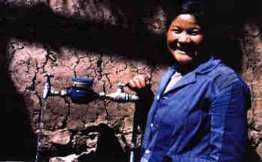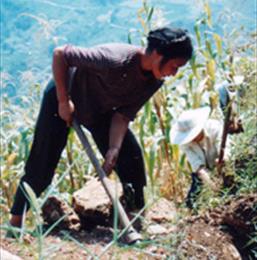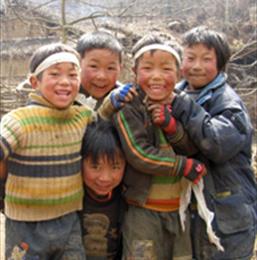Chenhe Village, Hanyuan 1997-2001
In the north of Hanyuan County, 1,900m above sea level, Chenhe Village sits nestled along the side of a steep river valley surrounded by high mountains that are snow capped in the winter. This part of the county seems especially dry. Every evening a fierce wind whistles around the gullies and though the valley.
DORS has implemented several projects in the village: a drinking and irrigation water supply project for the village hamlets, repair of a stretch of irrigation channel, named after Chenhe Village, which provides much needed irrigation water for many villages, and also a social and community forestry project. .
Chenhe Village Hamlet 3 Drinking and Irrigation Water Supply
Hamlet 3, is located on a rough track leading off up the hill from the north bound road out of Jiuxiang, a bustling market town which is the second largest town in Hanyuan County.
 This track divides hamlet 3 into two parts. The largest group of homes lies below the track and is enclosed by dry, red soil fields with fruit trees scattered along the field boundaries. A small stream runs through the cluster of households. This water is used for drinking and irrigation, although everybody has to travel more than 300m up the stream gully to fetch water in back buckets or two buckets carried on a shoulder pole. Above the small track, the people from the few houses there, must again fetch water from a small well.
This track divides hamlet 3 into two parts. The largest group of homes lies below the track and is enclosed by dry, red soil fields with fruit trees scattered along the field boundaries. A small stream runs through the cluster of households. This water is used for drinking and irrigation, although everybody has to travel more than 300m up the stream gully to fetch water in back buckets or two buckets carried on a shoulder pole. Above the small track, the people from the few houses there, must again fetch water from a small well.
Due to the nature of this supply and also because the stream runs through very dry earth, the existing water supply is hardly sufficient for the villagers needs. During winter months, all the villagers have to walk one and a half kilometres to fetch water and once there have to wait for a long time, as the flow rate is so low. This is on top of the daily inconvenience of carrying buckets full of water three or four times a day.
The aim of DORS' project in hamlet 3 is to assist the 236 people of the village in constructing a simple water supply. This uses steel piping to take water from the source higher up the mountain side to water storage tanks, and from there smaller pipes will ensure that every household in the hamlet will have fresh water in their home.
In addition to drinking water the project will enable the village's existing 30 mu of paddy land, which is used for growing winter wheat, to be doubled to 60 mu. The villagers also grow fruit trees, which would benefit from more irrigation water being available.
For more details on the village conditions and agriculture see our Chenhe Village baseline study of hamlet 3 which we carried our before work on the project began.
Thanks to a donation from Misereor of Germany, work on this project began in November 1997 and the project was finished in April 1998.
Chenhe Village Hamlet 6 Drinking Water Supply Project
 As in hamlet 3 the outline aim of this DORS project is to use steel piping to supply drinking water to all households -116 people - of Chenhe village hamlet 6.
As in hamlet 3 the outline aim of this DORS project is to use steel piping to supply drinking water to all households -116 people - of Chenhe village hamlet 6.
Hamlet 6 is situated on the same hillside as hamlet 3 although lower down. The village has paddy fields irrigated by Chenhe irrigation channel but drinking water remains a problem. Some people in the village have small plastic pipes to bring water from the mountain streams to their houses whilst the remaining households fetch water from the source on a daily basis. The sources are insufficient during winter, and the piping is of poor quality, leaking in several places. Around one third of the households have to walk to fetch their water from the mountain streams all year round.
The water sources to be used for the new supply are two mountain springs near the village. The water will be piped into two masonry water storage tanks, from where further piping will take the water directly to the household courtyards.
This project was able to begin in December 1998 and was completed in April 1999.
Chenhe Village Hamlet 2 Drinking Water Supply Project
A further water supply was designed by DORS and implemented by the village party secretary Chen Dongxiang. This water supply was completed in July 1999. The following is part of the evaluation report for the project
Introduction
The purpose of this report is to monitor the progress of the project. The full DORS contribution has been made towards this drinking water project. The outline aim of the project was to use steel piping to supply drinking water to all households of Chenhe Village Hamlet 2, supplying water to 146 people. The water source used was a mountain spring near the village. This water is now piped into one masonry water storage tank, from where further piping takes the water directly to the household courtyards.
Project Organisation
The project was carried out in conjunction with the villagers of Chenhe Hamlet 2. The DORS' contribution was made directly to the village leader Mr Chen Dongxiang. He made the purchases and arranged for the construction work. A preliminary design plan was prepared by DORS, specifying the quantities of materials needed. An agreement was drawn up between the village and DORS for the project, specifying how it should be carried out, and making clear DORS' requirements; such as ensuring that all households would be connected to the new supply. This agreement was signed in April 1999. A DORS volunteer visited the village to review progress in October 1999.
Project Finance
The total project cost was 16,653.6 CYN (£1281). DORS provided 15,600 CYN at the signing of the contract, and after project evaluation DORS paid the extra-budgetary expenditure of 1054 CYN.
Receipts were provided to DORS for all purchases and were in order. See Appendix 1 for breakdown of project expenditure. The per capita cost of providing a clean, secure drinking water supply was 114 CYN (£8.77).
Construction of Water Supply
The Village leaders purchased the piping and materials for the project and arranged for transport and storage in the village.
The villagers did the construction work and laying of the pipes.
The masonry tank was constructed first.
Piping to the water tanks from each of the sources was laid, then smaller piping to each village group. These steel pipes are buried underground in places. Smaller diameter branch pipes then take water into each home.
The plan was modified slightly in that the drinking water tank was built with a larger capacity than agreed.
All the households are now connected to the new supply.
Maintenance
There is no funding provision for maintenance out of the DORS budget, but the villagers themselves constructed the water supply [and thus are well able to maintain it]. There are no other users of their source. The costs of maintenance will be low, involving mainly the replacement of leaking taps and joints. We have been assured that the local people will take responsibility for maintenance themselves. If repairs are needed which are beyond the budget of the hamlet then DORS will consider further assistance.
Villager’s reactions
The people of Chenhe Village Hamlet 2 are pleased with their new water supply. Everybody spoken to thanked us and showed us their courtyard taps.
Prior to the project, the situation in the village was as follows: Most people were using water from Chenhe irrigation channel for all household needs. This water was running in an open ditch, polluted with mud and animal droppings. The channel is also used for washing clothes. Some people in the village had plastic pipes to bring water from the channel to their houses and others fetched water in wooden back-buckets. Apart from the water not being of a suitable quality for human consumption the channel was often damaged by heavy rains causing the sides of the channel to cave in and was therefore running dry several times a year. During these periods people had to walk to alternative sources up to 1000m away. After any rain the channel was muddy and unusable for several days. All the villagers we asked said that the new supply is very convenient and much cleaner.
Overall Evaluation
Overall the project has been successful. The project took less than 3 months to complete. The village had no problems managing the project. The main benefits are that the villagers now have a clean and sanitary water supply, which is available all year round, and moreover is located conveniently in their homes and courtyards.
Next Review
The project will be evaluated again in one year’s time to check it is still working well.
Chenhe Irrigation Channel Repair Project
An irrigation channel named after Chenhe Village, flows from the neighbouring village in Xixi Township through Chenhe and into the next township Fuzhuang. The area of paddy (rice fields) irrigated by this channel is 700mu or 47 ha. 13 village groups depend solely on this channel for their irrigation water, not just for the paddy fields but also for their other crops such as winter wheat and their main cash crops, fruit trees.
The channel is in a state of disrepair. Several sections are leaking, jeopardising these villages' rice crops. A recent earthquake destabilised the soil, so with heavy rains or snow melt, the slopes slide into the channel.
Over 500 m was repaired in April 1997. However, a 400 m section between Chenhe hamlet 4 and hamlet 2 is still leaking badly. The channel has been repaired many times in the past but without cement the walls quickly wash away. On the valley bottom a new road is being built joining Xixi Township with Fuzhuang Township. Leakage from the channel high above are destabilising the hillside lower down and causing rock and earth falls onto the road.
To repair this channel building materials are needed. The Township and Chenhe are unable to find the funds to buy the materials. DORS has agreed to assist in the purchase of construction materials.
It has been estimated that 80 tonnes of cement and 20 tonnes of sand are required, and also the cost of their transport to the village. The Water Conservancy Bureau of Jiuxiang Town has prepared the design plan. The channel will be cemented on three sides; the hillside wall will be built up and reinforced so that it will not collapse into the channel.
This project was also funded by a donation from Misereor of Germany and work began in November 1997. The project was completed in December 1997.
Social and Community Forestry Project
DORS received a project proposal from the village of Chenhe through Chen Dongxiang, a township cadre and Party secretary of the village.
Initial proposal
The proposal was for an agroforestry system incorporating chestnut, walnut and huajiao with a high yielding agricultural arable component. The total area being approximately 80 mu (5.3 ha) in which 7000 chestnut and 2000 walnut trees will be planted along with 168,000 huajiaobushes. The aim of this was to create revenue that could be used for the village as a collective and to be a pilot/demonstration project to show how forestry can help in the alleviating poverty
The management and ownership will be collectively based; the land to be used is predominately collective barren mountain land, with an additional 15 mu (1ha) of hamlet fours agricultural land, of which 11 household hold the user rights.
The proposal given by Chen Dongxiang was technically good, however it was still explained to him and the other leaders of the village that before DORS could proceed with support, there would be a need for in depth socio-economic surveys of the village. And these surveys would be participatory in nature to ensure any ideas, fears and grievances of the villages/stakeholders to come forth as well as ascertaining the socio-economic situation in the village.
Through this participatory rural appraisal process and its feedback meetings the initial proposal was improved upon and the main concerns and wishes of the stakeholders dealt with. The following is a brief outline of these additions.
Development of the initial proposal
The profits generated by the sale of the non-timber forest products and agricultural crops will be used for the infrastructural improvement of the village and the support of the poorest members of the community. The project will also be used as a demonstration pilot scheme for the village to see how economic development through forestry can be achieved. As 11 households in hamlet four hold the user rights to 15 mu of the land a 30% allocation of the profits will be made to these household in accordance to their amount of contracted land. The remaining profits will be put into a bank account in Jiuxiang, and managed by a democratically elected project management committee, which will be put in place to oversee and organise all works and financial requirements. So ensuring the equitable and appropriate use of all funds.
This committee will be expected to be fully accountable to the people of Chenhe and the village leadership and hamlet heads must approve all decisions. Additionally the committee will be expected to meet at least once a year, which will be minuted and the minutes made public, as will all accounts and administration.
Completion of participatory rural appraisal
On completion of the participatory rural appraisal over a four month period, it was clear that the villagers had no objection to the project and had trust in the village leadership. Many had expressed a desire to develop their agricultural land independently, however, the collective project was supported equally as the two forms of forestry development were considered to be totally autonomous.
Therefore, it was decided that DORS would support the project as the people had faith in the initiative and its potential as a form of training or pilot scheme for the villagers to develop their land in the future.
This project began in 21st December 1999


